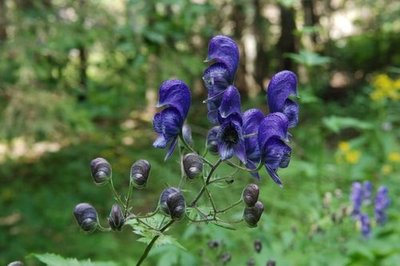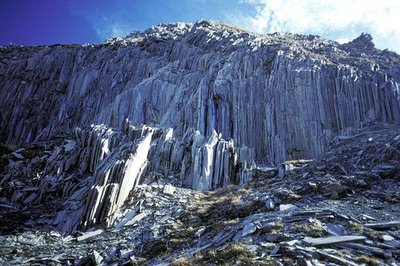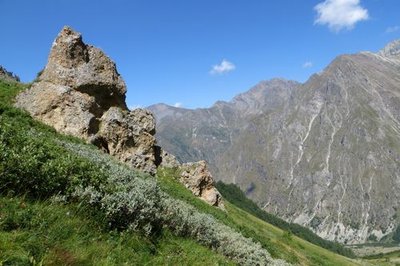
Col de Côte Belle from Valsenestre
The trail makes for a very pleasant walk. At first, it is shaded, filled with flowers for much of the summer and rises in well-marked loops to the mountains pass. The trail is a chance to immerse yourself in several natural environments, showing you how the vegetation adapts to the terrain, as you go upwards through forest, tall grassland and Alpine grasses. A big surprise, when you get to the Organs - you feel like you have arrived on another planet, the result of a natural evolution of the limestone rock and limestone schist.
Georgette Guidetti, Secretary-receptionist in Valbonnais
Description
From the village of Valsenestre, go up the track alongside the Béranger torrent, past the limits of the National Park and you arrive at the Les Touches bridge. Continue as far as a fork and follow the path to the right. The path enters a small wood of resinous trees, then runs alongside the stream at the bottom of the gorge before finally moving away to the left as it rises in altitude. Here, you can see the torrential corrective work (wooden dams) conducted by the RTM restoration services. Continue upwards along a winding path through the forest. On the way, you will come across a fairly rare plant, the pleurospermum austriacum. Cross the high grassland, with a whole host of plants, including the aconitum variegatum and the achillea macrophylla. A little higher, you will see the Alpine columbine, after which the low-lying Alpine grass gradually replaces the forest. Continue up to the Valsenestre Organs. Through wide loops, you arrive at the mountain pass to see a very fine panorama. Follow the same route on the way back. The descent is also possible towards Le Désert en Valjouffrey.
- Departure : Valsenestre
- Towns crossed : Valjouffrey
9 points of interest

Prairie de fauche - Marc Corail - PNE  Flora
FloraNatural Hayfields
Agricultural specialists consider a meadow as natural if it has not been ploughed or fertilised over the last ten years. This is the case for those that you will see, surrounded by hedges, at the start of the hike. The meadows have an important variety of plant life and consequently attract multitudes of pollinating insects, including domesticated bees of course.
Mégaphorbiaie - Pierre-Emmanuel Dequest -PNE  Flora
FloraTall herb fringe communities
Tall herb fringe communities form a landscape linked to very precise conditions in terms of climate (wet summers and snowy winters), topography (long ubac slopes where névé sometimes remains on the ground deep into the summer), altitude (subalpine tier from 1600 to 2100 metres) and soil (unsaturated soils with large water reserves).

Barrages du torrent du Béranger - Samy Jendoubi - PNE  Water
WaterTimber dams
In the Combe des Echarennes, as you take the path to the left, you can see, in the gorges of the Béranger mountain stream, wooden dams made by the RTM (mountain terrain restoration department of the National Forests Office) to hold back the flow of debris carried down from the mountains during heavy rain and floods.

Aconit paniculé - Bernard Nicollet - PNE  Flora
FloraMonkshood
This is a typical plant in tall herb fringe communities, measuring 50 to 100 cm. It has royal blue flowers shaped like helmets and grouped together in loose bunches. Their particularity is that they are highly toxic! Herbivores are aware of this and don’t eat them.

Pleurosperme d'Autriche - Bernard Nicollet  Flora
FloraPleurospermum austriacum
This robust hardy perennial with a thick, hollow and grooved stalk belongs to the parsley and carrot family, and can grow from 60 to 150 cm high. Its large umbels of white flowers bloom from July to September. Very little known, in France it only grows in the Alpine areas and for this reason is worthy of attention.

Ancolie des Alpes - Mireille Coulon - PNE  Flora
FloraAlpine columbine
This is an uncommon and protected species, measuring 30 to 60 cm. The flowers are quite large and have a magnificent blue colour, blossoming at the head of the stem, and are the only ones with afive petals in the corolla. They are not to be confused with the common columbine, which has smaller flowers and is more widespread.

Les orgues au col de Côte Belle - Lucien Tron - PNE  Geology and geography
Geology and geographyCôte Belle organs
A striking geological phenomenon, the big organs , also known as the big library, were formed when the Alps were born. They were formed by thin grey-blue limestone sheets and by more highly eroded soft schistose marl. A series of perpendicular cracks in the layers divide the slabs into remarkable columns.

Troupeau de brebis - Mireille Coulon - PNE  Pastoralism
PastoralismFlock of sheep
A flock of sheep belonging to local farmers graze at the summit of the mountain pass near the Pic de Valsenestre. In summer these animals with their thick woolly coats can enjoy the shade of the willows that you can see just before arriving at the col (alt. 2220 m).

Saule soyeux - Bernard Nicollet - PNE  Flora
FloraEuropean violet willow
This is a shrub in the subalpine tier. It is less than one metre tall and grows in small groups on the ubac. At lower altitude, it may grow taller. You can recognise it from a distance through its characteristic shiny, silvery colour and its growth in circular beds. Adult leaves feel very silky on both sides.
Forecast
Altimetric profile
Sensitive areas
Golden eagle
- Impacted practices:
- Aerial, , Vertical
- Sensitivity periods:
- JanFebMarAprMayJunJulAug
- Contact:
- Parc National des Écrins
Julien Charron
julien.charron@ecrins-parcnational.fr
Information desks
Maison du Parc du Valbonnais
Place du Docteur Eyraud, 38740 Entraigues
Reception, information, temporary exhibition room, reading room and video-projection on demand. Shop: products and works of the Park. Free admission. All animations of the Park are free unless otherwise stated.
Access and parking
D26 from La Mure. D526 from Pont du Prêtre. D117 from Entraigues to La Chapelle et Valsenestre.
Parking :
Source

Report a problem or an error
If you have found an error on this page or if you have noticed any problems during your hike, please report them to us here:


